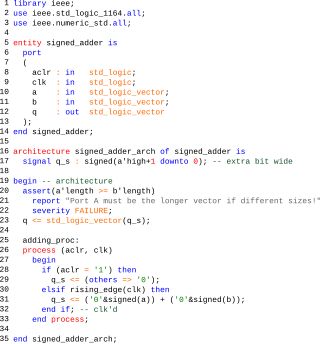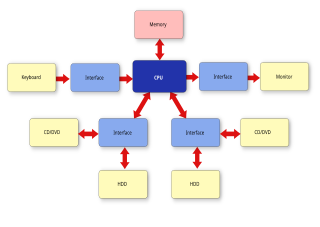
Niklaus Emil Wirth is a Swiss computer scientist. He has designed several programming languages, including Pascal, and pioneered several classic topics in software engineering. In 1984, he won the Turing Award, generally recognized as the highest distinction in computer science, for developing a sequence of innovative computer languages.
In computer science, pseudocode is a description of the steps in an algorithm using a mix of conventions of programming languages with informal, usually self-explanatory, notation of actions and conditions. Although pseudocode shares features with regular programming languages, it is intended for human reading rather than machine control. Pseudocode typically omits details that are essential for machine implementation of the algorithm. The programming language is augmented with natural language description details, where convenient, or with compact mathematical notation. The purpose of using pseudocode is that it is easier for people to understand than conventional programming language code, and that it is an efficient and environment-independent description of the key principles of an algorithm. It is commonly used in textbooks and scientific publications to document algorithms and in planning of software and other algorithms.
In computer programming and software design, code refactoring is the process of restructuring existing computer code—changing the factoring—without changing its external behavior. Refactoring is intended to improve the design, structure, and/or implementation of the software, while preserving its functionality. Potential advantages of refactoring may include improved code readability and reduced complexity; these can improve the source code's maintainability and create a simpler, cleaner, or more expressive internal architecture or object model to improve extensibility. Another potential goal for refactoring is improved performance; software engineers face an ongoing challenge to write programs that perform faster or use less memory.

The VHSIC Hardware Description Language (VHDL) is a hardware description language (HDL) that can model the behavior and structure of digital systems at multiple levels of abstraction, ranging from the system level down to that of logic gates, for design entry, documentation, and verification purposes. Since 1987, VHDL has been standardized by the Institute of Electrical and Electronics Engineers (IEEE) as IEEE Std 1076; the latest version of which is IEEE Std 1076-2019. To model analog and mixed-signal systems, an IEEE-standardized HDL based on VHDL called VHDL-AMS has been developed.

Software architecture is the set of structures needed to reason about a software system and the discipline of creating such structures and systems. Each structure comprises software elements, relations among them, and properties of both elements and relations.
In computing and computer programming, exception handling is the process of responding to the occurrence of exceptions – anomalous or exceptional conditions requiring special processing – during the execution of a program. In general, an exception breaks the normal flow of execution and executes a pre-registered exception handler; the details of how this is done depend on whether it is a hardware or software exception and how the software exception is implemented.
Verilog, standardized as IEEE 1364, is a hardware description language (HDL) used to model electronic systems. It is most commonly used in the design and verification of digital circuits at the register-transfer level of abstraction. It is also used in the verification of analog circuits and mixed-signal circuits, as well as in the design of genetic circuits. In 2009, the Verilog standard was merged into the SystemVerilog standard, creating IEEE Standard 1800-2009. Since then, Verilog is officially part of the SystemVerilog language. The current version is IEEE standard 1800-2017.
In computer engineering, a hardware description language (HDL) is a specialized computer language used to describe the structure and behavior of electronic circuits, and most commonly, digital logic circuits.
In computer science, formal methods are mathematically rigorous techniques for the specification, development, analysis, and verification of software and hardware systems. The use of formal methods for software and hardware design is motivated by the expectation that, as in other engineering disciplines, performing appropriate mathematical analysis can contribute to the reliability and robustness of a design.
A software requirements specification (SRS) is a description of a software system to be developed. It is modeled after the business requirements specification (CONOPS). The software requirements specification lays out functional and non-functional requirements, and it may include a set of use cases that describe user interactions that the software must provide to the user for perfect interaction.
Architecture description languages (ADLs) are used in several disciplines: system engineering, software engineering, and enterprise modelling and engineering.

Hardware acceleration is the use of computer hardware designed to perform specific functions more efficiently when compared to software running on a general-purpose central processing unit (CPU). Any transformation of data that can be calculated in software running on a generic CPU can also be calculated in custom-made hardware, or in some mix of both.

A system architecture is the conceptual model that defines the structure, behavior, and more views of a system. An architecture description is a formal description and representation of a system, organized in a way that supports reasoning about the structures and behaviors of the system.
A logarithmic number system (LNS) is an arithmetic system used for representing real numbers in computer and digital hardware, especially for digital signal processing.
High-level synthesis (HLS), sometimes referred to as C synthesis, electronic system-level (ESL) synthesis, algorithmic synthesis, or behavioral synthesis, is an automated design process that takes an abstract behavioral specification of a digital system and finds a register-transfer level structure that realizes the given behavior.
Offset binary, also referred to as excess-K, excess-N, excess-e, excess code or biased representation, is a method for signed number representation where a signed number n is represented by the bit pattern corresponding to the unsigned number n+K, K being the biasing value or offset. There is no standard for offset binary, but most often the K for an n-bit binary word is K = 2n−1 (for example, the offset for a four-digit binary number would be 23=8). This has the consequence that the minimal negative value is represented by all-zeros, the "zero" value is represented by a 1 in the most significant bit and zero in all other bits, and the maximal positive value is represented by all-ones (conveniently, this is the same as using two's complement but with the most significant bit inverted). It also has the consequence that in a logical comparison operation, one gets the same result as with a true form numerical comparison operation, whereas, in two's complement notation a logical comparison will agree with true form numerical comparison operation if and only if the numbers being compared have the same sign. Otherwise the sense of the comparison will be inverted, with all negative values being taken as being larger than all positive values.
Linda Rising is an American author, lecturer, independent consultant. Rising is credited as having played a major role in having "moved the pattern approach from design into corporate change." She also contributed to the book 97 Things Every Software Architect Should Know, edited by Kevlin Henney and published by O´Reilly in 2009 (ISBN 059652269X).
Cache prefetching is a technique used by computer processors to boost execution performance by fetching instructions or data from their original storage in slower memory to a faster local memory before it is actually needed. Most modern computer processors have fast and local cache memory in which prefetched data is held until it is required. The source for the prefetch operation is usually main memory. Because of their design, accessing cache memories is typically much faster than accessing main memory, so prefetching data and then accessing it from caches is usually many orders of magnitude faster than accessing it directly from main memory. Prefetching can be done with non-blocking cache control instructions.
Signal Transition Graphs (STGs) are typically used in electronic engineering and computer engineering to describe dynamic behaviour of asynchronous circuits, for the purposes of their analysis or synthesis.
Marvin Victor Zelkowitz is an American computer scientist and engineer.




